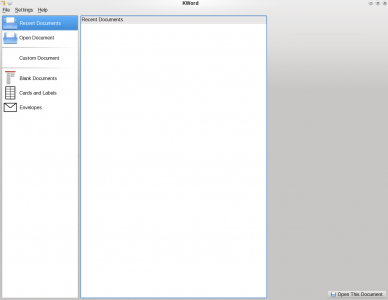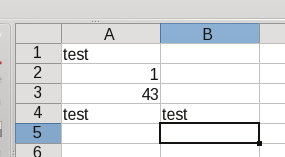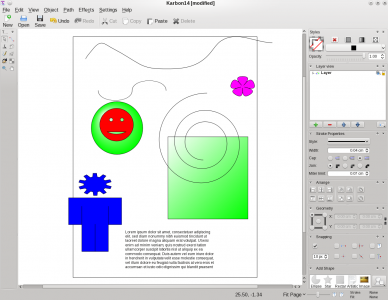At the time there were two neat things about KWord that I really liked and they both stemmed from something I was doing at the time. I was the head of the Phi Sigma Pi (scholastic frat) alumni team. We had a newsletter to get out. Turned out that KWord, as it worked at the time, allowed for very easy desktop publishing. I don’t think it was intended to replace Scribus, but when compared to Microsoft Word or OpenOffice.org Writer, it was MUCH easier to set the layout. That made it really easy to create. With MS Word (at least 2000 and 2003) it was SUCH a PITA to try and get images where you wanted to be and to have text properly wrap around it. We had all kinds of issues in this class I took my sophomore year in which we had a tutorial class session on how to do this and it was still horrible to work with. KWord also had the ability to output to PDF which was great as I was trying to help the frat save money by seeing if we could get the alumni to accept emails instead of letters. They ended up rebuffing that offer, but at least it was something I was able to do. (I hadn’t discovered cutePDF and other ways to create free PDFs on Windows)
Eventually I had to abandon KOffice in favor of OpenOffice.org because KOffice had horible compatibility issues with Microsoft Office. It’s a harsh fact that most people out there (in the USA, anyway) use MS Office and when they went to their XML file format, KOffice was no longer an option. In the meantime, The OASIS group came up with ODF. OpenOffice.org was quick to jump on that. I thought that all of the FLOSS would get there quickly too – it was a no-brainer. But, strangely it took Abiword and KOffice a while to get there. I think it may have to do with the fact that they were waiting for 1.1 or maybe, in the case of KOffice, they were busy getting ready for KOffice 2.0.
Now I’m no longer in school. (Haven’t been for quite some time now) KOffice 2.x supports ODF. OpenOffice.org supports ODF. I only share documents with my wife and if I have to send them to my parents I can always either save as doc or PDF. (Also, there are ODF interpreters for MS Office) So I can use whatever program I want for my office suite. I want to take a look at all that KOffice has on offer. However, since I’m no longer in school and don’t use KDE at work (nor can I take home work – corporate espionage fears and all that), I don’t care about KPresenter. I also almost never write anything that needs something as heady as KWord. So my main office program is the spreadsheet. I have spreadsheets for my workout weights, my time off (so I know in advance how much time off I’ll have at a given point in the year), and some other stuff. I’ll also take a look at Karbon14 vs Inkscape although I’m pretty happy with Inkscape for my work on my webcomic.
I figured I’d take a look at the wikipedia pages and the offical KOffice pages before trying them out to see if I can glean any important info that will help with my eval. The KWord article on Wikipedia was short, but confirmed that they are still using Frames. Taking a look at the KWord official site is pretty exciting. First of all, it looks at thought KOffice (or at least KWord) has been optimized for the fact that “everyone” has widescreen monitors now. It looks like they’ve used this extra space to the right to create a variant on MS Office’s ribbon interface. What I like about it is that it looks a lot less confusing than the way MS did it. The top bar isn’t constantly changing and important things like the “save” icon aren’t hidden. (Of course, I also take a moment to note that, like an expectation of high bandwidth – widescreen monitors may not be readily available everywhere)
KSpread’s Wikipedia page has some conflicting info on XLS support, but that’s not as important to me at this stage in my life. The official page shows that also looks pretty slick. The real test will be if it can import my ODS files from OpenOffice.org without any problems.
The KPresenter page on wikipedia is pretty much useless. The official page shows that it’s basically what you expect. Nicely, it does have a plugin architecture so if you’re doing presentations off your own machine you could probably find some nice plugins for special effects or something.
With Krita KOffice goes above and beyond other office suites and offers a bitmap (or raster) editor. The GIMP is also a bitmap editor. So I asked on Identi.ca and got the same information that’s on the wiki page and the official page. Basically, it’s intended to be for drawing and digital painting. So while The GIMP, like Photoshop, has to be a jack-of-all trades and, therefore, quite complicated (having to handle photography, image manipulation, and drawing), Krita can focus on the drawing part. I could see Krita potentially gaining more and more users among the web comic industry. (Windows compatibility is being worked on for the 2.3 release) After all, why use The GIMP or pay tons of money for Photoshop (which has PHOTO in the title) when you’d have this program perfectly tailored for artists? I’m looking forward to playing with this and recommending it in my web comic circles. (I use Blender for most of my art so I probably wouldn’t use it too much)
In fact, using Krita for drawing your webcomic would be great because KOffice also includes Karbon14, a vector drawing program. After all, vector programs are great for speech bubbles and text. So you could load your image from Krita into there and given that it’s all one office suite, probably have it automatically updating. The official page is here.
The last three parts of of KOffice are programs I’ll nearly never user. Kexi is an open source version of MS Access and much more. It can, for example, connect to a MySQL database. I have never used one of those because I’ve never had a task that was better suited to a database than a spreadsheet. (This may change as I setup a database for something my wife does – I think it might work better for her) KPlato is a project management tool. I usually don’t use those in my day-to-day life. I just don’t have projects that are large enough to be worth the effort. I used to use one when I was working on animation projects. Finally, there’s Kvivio a diagram program. But that one’s not even ready for KOffice 2 so I’m not going to look at it.
KWord
So here’s what it looks like when you start KWord. (Pretty much every part of KOffice looks like this when you start it)

I’m really conflicted about this. On the one hand, it’s kind of dumb that MS Office and OpenOffice.org open up a blank new document upon startup – what if you want to use a template or open a file. On the other hand, this stands in the way of getting started right away. Part of me thinks that the traditional way is better because you can just start writing right away. So I click on blank document. This gives me more choices.

I expected to be in Kword by now. I’m one of the first people to yell when we cater to “stupid users” but this is quite counterintuitive to what I thought would be here. To me, blank document means no templates. So I click on blank page. So here’s where it leaves me (and I’ve typed some nonsense)

So what do we have here? A great layout for a widescreen monitor. (I just happen to have it open on my left monitor, which is 4:3) I will tell you right now that this interface will probably scare the crap out of certain types of people – people afraid of change. There are a LOT of those people out there. That’s OK. Everyone doesn’t have to look like MS. It just means a shop going from Windows to KOffice will need to spend a bit of time and money on training. A neat thing for people participating in the Nanowrimo is that the word count is right there. Unlike other writing programs, you don’t have to keep going to a menu to check and see if you’re hitting your word count. So I played around with the other stuff to see how it works.

I learned that KWord also bucks another trend. To stop bullets you don’t hit enter twice and you don’t hit the bullets button again. You just backspace over the bullet. More intuitive to someone who’s never used a word processor. Less intuitive to those of us who have used them nearly our entire lives. Another thing I noticed is that it doesn’t appear to be doing live spell checking. Perhaps that’s an option that needs to be enabled.

Yup, it was off. Hmm….turning it on didn’t fix it automatically. Maybe I need to go back in? Hmm, that doesn’t appear to fix it either. Well, that’s more or less a deal-breaker. But let me see if perhaps I just don’t have the dictionaries installed. Well, I do have enchant installed. So now what? I asked identi.ca. We’ll see if they get an answer back to me before I publish this.
KSpread
OK, onto KSpread. As I said before, this one is the most important one to me. First I open up a spreadsheet where I keep track of my vacation hours. I created this in OpenOffice.org’s Calc. I was not impressed with how it looked.

While all the into was there and the formula appeared to be working correctly (I didn’t check), it looked horrible. Looking at that for too long would really hurt my eyes. Why does it look so bad? Why are the rows so small? Let me check my workout weights spreadsheet:

Again with the lack of vertical space! It also doesn’t appear to preserve horizontal space either. Well, let’s see what happens if I start from scratch.

So that works. Not a good sign for interoperability, but at least if you make it in KSpread to begin with and only work in there you should be good.
KPresenter
KPresenter appears to need a lot more work. I just opened up a blank page, picked the second layout and did the most basic thing that’s in every slide show – bullet. They look horrible.

I’m sorry, but presentation software needs to handle bullets correctly. That’s something that’s in EVERY presentation. Let’s see how it does at presentations. At least that works correctly. Get the bullets fixed. Then we’ll worry about fading and special effects.
Krita
Krita works well. It’s somewhere between Tuxpaint and The GIMP. Looks like it would take some time to master and get really good with it.

Very promising. I hope it continues to get support.
Karbon14
I created a default page in Karbon.

After my experience this morning where it appeared that there was no way to put text into Karbon14, I was about to write it off as needing a lot more work. Turns out that it was hiding under the circle/triangle/square button on the bottom right. I understand this leads to a consistent experience across all of KOffice. I think there’s merit in that. But a vector graphics program is all about graphics. And so all the shapes shouldn’t be hidden like that! Neither should text as that can potentially be important. I also tried opening up an Inkscape SVG file. It appeared to open correctly – a very good thing.
Kexi
Starting it up seemed more involved than I wanted to get into.
KPlato
It appeared to have everything you’d need for a project management program. It would be way too hard to demo without a real project or a huge time commitment.
So what’s my verdict? It’s definitely a complicated one. On the one hand, it’s wonderful that KOffice includes all these programs. Their idea to use “shapes” and other such concepts is great. You’re really getting a nice, integrated office suite. Overall, the programs work as they should. KPresenter needs a lot more work. The others seem to be in good shape. (Other than the spelling issue) The biggest disappointment was with the interoperability. I understand there probably isn’t coding in the spec for cell size, but for it to look so atrocious. It just sucks. So try it out. It will most likely meet your needs after you get used to the interface. Hopefully it evolves so that programs like Karbon14 don’t have all the important stuff for that program hidden away just to maintain visual consistency.

5 responses to “KDE Look Part 5: KOffice 2”
It would be interesting to know which version you are reviewing. From the sound of it, it looks like 2.2. You should be aware that the release of version 2.3 is really close now, about a month if things go well.
It’s 2.2.2 – I hope that 2.3 comes out with this version of Fedora and we don’t have to wait until the next one. I’m not sure – they’re mostly consistent about only upgrading programs along with a distro upgrade, but sometimes they don’t wait.
Hi! Really nice write-up — and very useful for us developers :-). I’m the Krita maintainer, and if you have any specific remarks about Krita or ideas on how to make it more suitable, don’t hesitate to mail me (boud@kde.org) or come to our irc channel (#krita on irc.freenode.org).
On nitpick: ODF was actually a joint effort between KOffice and OpenOffice, and KOffice supported it with version 1.4 already. And as Inge said, KOffice 2.3 should be much nicer already, although still not really there, for KWord.
OK. If I can think of something good and constructive I’ll be sure to send an email your way.
[…] KDE Look Part 5: KOffice 2 Back when I first started using Linux I was using a very underpowered computer that I got donated as part of my research at school. So OpenOffice.org was a real pain in the butt to use. It took forever to load! KOffice, on the other hand, loaded up quickly. At that time, with KOffice 1, they had the presentation program, the spreadsheet, and the word processing program. […]